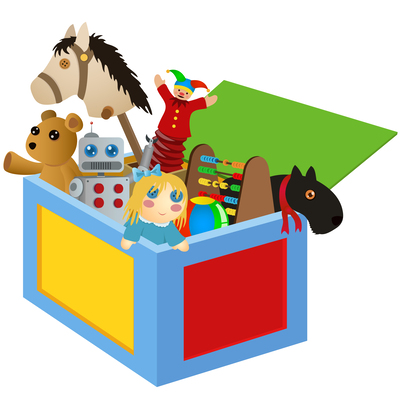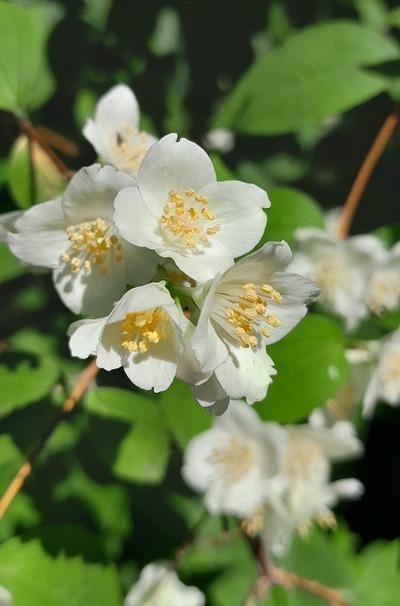
Here is a most random post of a kind that I have never tried to get involved in: one long, constantly updated, written-throughout-the-entire-summer post, with all the fun things I did in class. A kind of a Summer 2023 Diary.
A little bit of a background: this summer I am teaching at a non-residential summer camp, for primary school children that has a special curriculum and a set of materials that were prepared by the educational management team at my school. Naturally, we, the teachers, are allowed to adapt and supplement these and, naturally, I am doing a lot of that. Here are my favourite bits so far.

I really like to swim
This is a small case study in the theme of ‘How to use a song effectively to teach vocabulary and to practise a grammar structure’ and I am very happy to share it here. Here is to hoping that the framework and the pattern can be adapted and re-used with other songs.
The song that we used was the amazing Milo and ‘I like you’ from Super Simple Songs. I love this song not only because of Milo but also because it includes a long beautiful list of verbs (hobbies and activities) that, as a result of the song, become a part of the kids’ vocabulary.
We started with the vocabulay introduction, with the teacher and kids miming, drilling the verbs and the structure (I like to read books) and playing Mime&Guess, with the teacher leading the game. I didn’t have flashcards to represent all the verbs that feature in the song so I prepared a set of my own mini-flashcards. Afterwards, we worked in pairs and the kids were miming the verbs for their partner to guess, each pair with their own set of cards. This way, the kids got a chance to get ready for the song itself. We listened to it and watched the video. At this point, I was singing but I didn’t push the kids to do so. I wanted them just to watch it and to enjoy it.
The following step was a proper pairwork. Each student got their copy of the handout and they were instructed to mark the activities they liked and didn’t like with pluses and minues. When this step was ready, we paired up, compared our lists and reacted (Student A: ‘I like to count stars’, Student B: ‘Me, too / I don’t’). This was something that we had already done in our lessons so it all went quite smoothly, including re-grouping. With six kids in that group, every student had a chance to talk to three different students.
At the very end of the lesson, we played the song again and, this time, I tried to encourage the kids to sing. Today, when I am writing this post, we have had only one lesson with this song and I am convinced the next time we meet in class, the response to this song will be even more active and productive.

Elephant
This is not a new idea. I have created this activity for my English and Art classes, again, with my pre-school students. However, the interaction of salt, water and paint is interesting in itself and it has a lot of potential for the older kids, as a science experiment and it was a part of a lesson with three experiments (together with the other two mentioned here, static electricity and the rainbow Skittles / M&Ms).
We went on with the drawing just like we did with the younger students, but the version for the older students included the following: learning the names of all the ingredients involved, trying to predict what we will do and what will happen (‘We will…’, ‘It will…’), describing the experiment while it was happening (Present Continous) and assessing it afterwards and grading it on a scale from 1 – 10.

Sugar Rainbow
No matter how old they are, the kids and the adults are simply in awe when they see the rainbow in a plate. Even if they have done this experiment before. Even if they are teachers. Speaking from experience here.
This is a very well-known experiment and you can find all the details here. I have used it so far in a lesson with my super advanced primary school kids to introduce and to practise the zero conditional. This time, since it is camp, we used it as a proper science experiment. The younger levels focused on the colours, the older and the more advanced ones could predict and assess and talk about the sugar dissolving fast and slow in the hot and cold water.
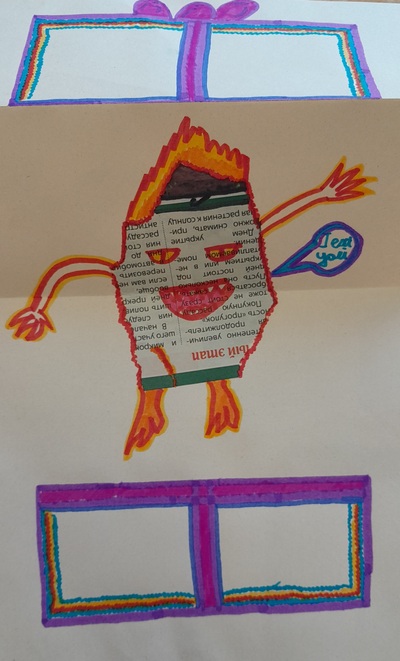
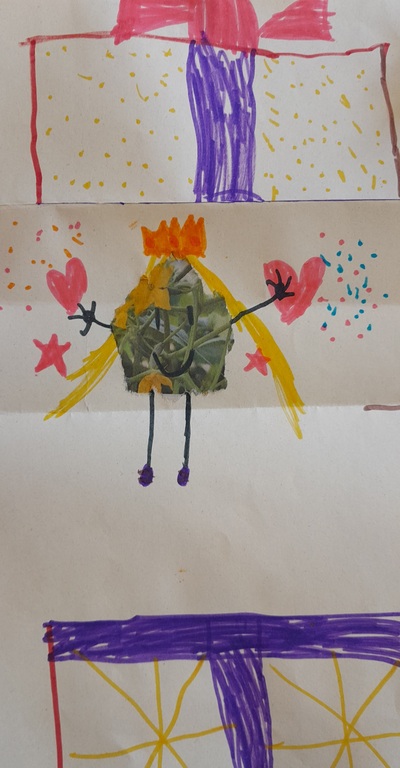
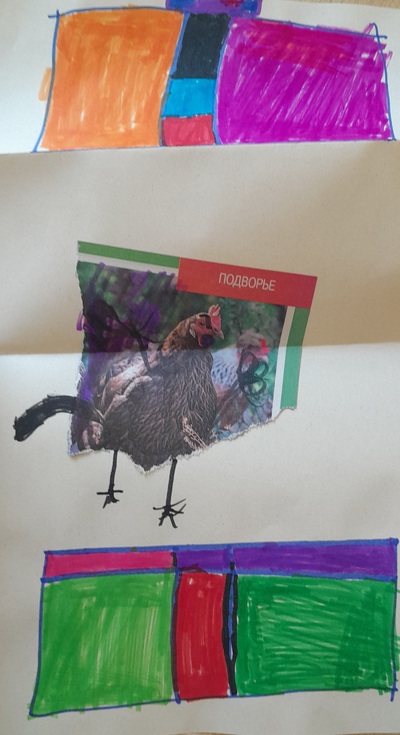
My little monster
I really love the folding surprise drawings and I have used them a few times in class already, although so far it has been done mostly with pre-schoolers and the follow-up activities involved a simple presentation, saying hello and a few Q&A, depending on the structure that we were practising at the time. It was an interesting experience to try to bring into the classroom with the older and the more advanced kids.
First of all, I decided to make it more creative and instead of a drawing dictation, with all the kids following the teacher and ending up with the same puppy or kitten, we all went our ways and created the monsters we wanted. One group used the collage technique using old newspapers and markers, the other opted for creating their own drawings and, indeed, in a short period of time they were actually able to draw their own beautiful monsters.
Second of all, I wanted a lot of language to come out of it. For that reason, as soon as the monsters were were, we sat in pairs and talked about them. The lower level group focused on describing the monster using the same structure (‘My monster has got…’), in a few rounds with different partners. The more advanced group had a set of questions starters (‘Has your monster got…?’, ‘Is your monster…?’, ‘Can your monster….?’ and ‘Does your monster like….?’) and they were able to keep up the conversation for a while themselves. The only requirement from the teacher, apart from the sentence starters, was to ask 20 questions.

Storybird
Storybird is a wonderful tool to develop kids’ imagination and the love for telling stories. You have to subscribe to be able to use it extensively but if you do, you get the access to a multitude of stories written by other users and their students and, even better, the access to a multitude of illustrations by budding artists which you can use in your stories. There is also an option of the trial period so you can start playing with everything that the website has to offer without investing and then you can make a decision whether you really like it or not. As for me, I haven’t even managed to go over everything that it has to offer but I am going to tell you about the one feature that I have used many times in my classes and why I love it.
We use Storybird to encourage the kids to express themselves more freely, in writing, without the hassle of actually having to write or type, during this delicate period when the students already have something to say but they do not yet have the fluency in writing, holding the pen, typing up or, in case of some my students, they do not write in English at all because they are still in pre-school. With the use of Storybird, I select the pictures and then kids talk and the teacher (yours truly here) is their secretary with quite a reasonable WPM (word per minute) numbers.
So far, I have used it in four different formats
- The oldest learners, in a group of 1-1s: a set of thematic pictures, with the same characters, that we look at, figure out the story, order and then tell the story, slide by slide. This can be done at any point during the course.
- Any group of learners: a set of any pictures, as the Year Book, at the end of the academic year, with the students choosing a picture to represent themselves and they can include anything they want about themselves, as they would in a year book.
- The younger learners in a group: a set of thematic pictures for example toys or animals in which a student chooses one for themselves and then talks about it, using a set of structures, depending on their levels and skills. Students take turns to talk to the teacher and there is also a need for a task that all the kids will be doing alongside such as a colouring page or a wordsearch
- The younger learners 1-1: a set of thematic pictures, for example toys or animals, with a student choosing 5 or 6 or how many of their favourite and they talk about every single one of them while the teacher is typing up.
Kids talk, either producing a discourse or a narrative with dialogues, the teacher types it all up, we publish it privately, we read it together, with either the students or the teacher reading the text and then, and this is definitely the best part, the book can be pdf-ed and downloaded and shared with everyone. There are even two modes for that: a simple e-book or a craft-version, for the kids to print it and assemble it into a real book which they can later read together with their parents.
If you are curious about the final product have a look at these stories we created together with my online and offline students: The Ballerina Cat and Her Friends, Our Toys and The Circus Story.
The only thing that I have a love-hate relationship with on Storybird is that since it was not created for the EFL teachers per se, it has a huge range of illustrations sets but in a rather random order. It gives me a lot of joy to be going over them and admiring the artword BUT it is time-consuming and you can use only the illustrations of one author in a book, without the options to collate different pictures. On the plus side, there are so many different styles and approaches represented that it can be used to teach Art, too. And, once you have found your favourite bits, you can reuse them with different groups.

The best transport in the world
This type of a speaking activity can be adapted to any set of vocabulary. We did it with transport because that was the theme of the day but I have already tried it with animals (‘The best animal in the world’), professions (‘The best job in the world’) and cities and countries (‘The best place in the world’), with different age groups and levels. This week’s camp group were kids aged 8 and 9 who are somewhere in the A1 level, mixed ability.
Before we started the game, I introduced the question (‘Which one is better?’) and a few comparatives to use while describing different means of transport (faster, slower, louder, quieter, more beautiful, more interesting, more expensive, more dangerous) and it is important to highlight that the students already knew all of these adjectives as we used them in some of the previous lessons of the course.
There is only one resource necessary and that is either a set of flashcards in a pile, a set of word cards or even a set of the electronic flashcards such as these, anything that guarantees that the words will be coming up at random.
The teacher or the students taking turns pick up two random cards and compare them, i.e. a boat a nd a bike, answering the question ‘Which one is better?’, they justify their answers and choose the one. Then we proceed to another random pair and so on, until we go through all the cards. The ‘winners’ or ‘the better ones’ in each pair are kept separately as they have qualified for round 2. The activity continues until there is one winner, the best transport in the world.
There are a few variations to the activity, for example, with bigger classes, the students can be divided into smaller groups and they can do the whole activity on their own, choosing their best trainsport. As the whole class feedback, the groups present their results or they can have the final of the finals. Another solution is diving the cards among the groups and having them run the qualifiers for the whole class debate to choose the winner. For the classes where the students don’t know each other very well or when they do not quite get on with the group, to avoid any kind of competition or peer pressure, the final stage can be replaced with choosing your Top Three, individually. Last but not least, there is the option of extending the activity into choosing the worst of the worst from among ‘the losers’. That is also a lot of fun.
Colouring dictation
I am pretty sure I have already described this activity somewhere here because I have been using it successfully for ages but this summer I am revisiting it and with a lot of joy, too.
Preparing the activity is very simple as you need only a picture to colour with a copy for each student and a few sets of pencils, crayons or markers, one per pair. As for pictures, I usually use the YLE Cambridge Starters, Movers and Flyers listening materials (without the audio) or, even better, the black and white clip art. Googling ‘toys’ or ‘zoo animals’ or ‘clothes’ will give you a nice set of pictures. If there are some more complicated and less common words, I create my own pictures, also with the black and white clip art.
The more important aspect here is the setting up of the activity as its success (maximising production) will depend on it. I start with putting the students into pairs and assigning roles (‘a teacher’ and ‘a student’). Afterwards, I give out the copy and the pencils but only to the students as they will be the ones working hard.
The next step is modelling. In an ideal world the real teacher can do it with one of the stronger students, at the board: The teacher says ‘The rocket is green’ and the student colours the rocket green, then they continue with the other toys. ‘The teacher’ is the one making all the decisions, the student is listening and colouring. That’s the ideal world. I have had classes in which it was necessary to have a round of the teacher starting the activity in all the pairs, one by one and only later monitoring. It is not the most efficient as some pairs will be just waiting (and only possibly obsesrving) but it has been the most effective way of setting it up with new groups and students who have never worked in pairs before (yes, they do exist).
The students continue speaking, listening and colouring for some time and then they swap roles. They can continue colouring the same picture or the teacher can give out another set of copies. It is important to note that not all the items have to be coloured in. The roles swap can take place after 5 minutes, for example, depending on the group and the remaining items, toys, animals or clothes, can be coloured in later on. The kids can finish the picture in any way they want, without their partner’s instructions.
The best thing about this activity is that it can be done with even the lowest levels as the structure used is pretty simple but it gives everyone a chance to practise the key vocabulary and to listen and to speak. There is another way of extending it, in the feedback stage. Since all the kids will have a different picture, with different colours, they can share what they have either in a whole class feedback (Teacher: My giraffe is green and yellow. S1: My giraffe is pink. S2: My giraffe is yellow. etc) or, with another partner after they have been regrouped. A lot of production:-))
My astronaut passport
This is the lesson that I designed while trying to come up with an activity that could become a fun project lesson, something else than just a poster or a role-play. It is not my original idea, I have come across these online but I needed something that would be feasible with a group of primary beginners.
The main idea of the project is a kind of a role-play in which one student interviews the other in the format of a test. Our days was space-themed and that is why the kids were taking a test for an astronaut, answering the questions about themselves and about their skills (‘Can you…?’) because this was our target language on the day. However, this can be adapted to many topics such as a test for a traveller / explorer, a test for an athlete, a test for a student of English and so on.
I was considering a few different set-ups for this activity but since my group was a mixed ability group, my two strongest students did a lot of interviewing, with the kids taking turns to come up to the table to answer the questions and to demonstrate their skills. In the end, they also interviewed each other. All the kids who completed the test, were getting their passports with a stamp and they could sit down to decorate and to colour them. In the end, we had a small awards ceremony, with the appropriate music and applause.
I was happy because everyone really did practise the language and the kids were very excited about completing the tests successfully. So excited, in fact, that during the follwing lessons, on seeing some templates in my hands, they would ask again and again whether we would be doing the passports again. If you are planning a similar lesson, you can find my template here.
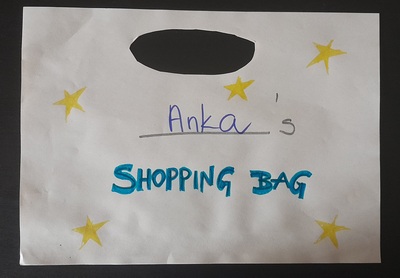
Going shopping
There is a separate post describing this activity and the resources necessary. You can find it here.
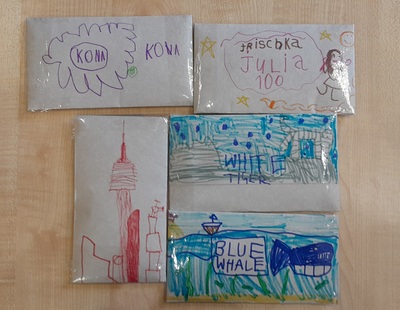
Making instruments and making music
This activity and this lesson has also become a post. You can find it here
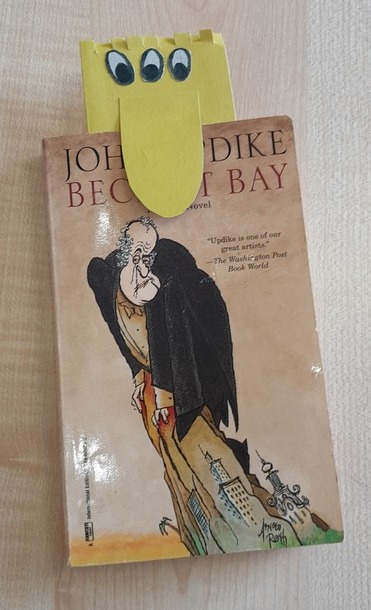
Monster bookmarks
Again, there is a separate post devoted to these beauties. You can find it here.
To be continued…
Happy Teaching!
